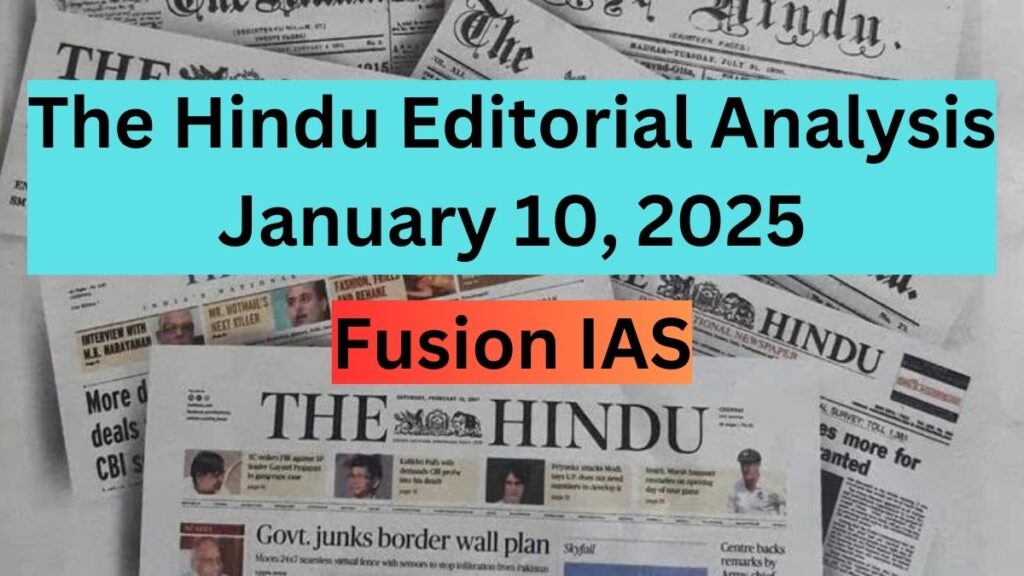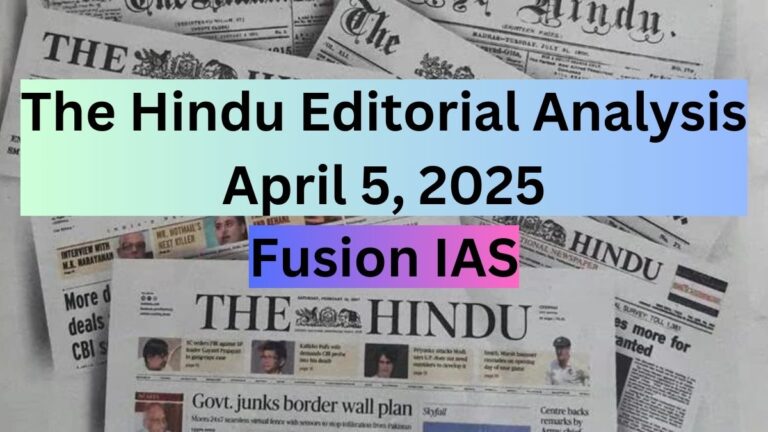
The Hindu editorials are a crucial resource for understanding key national and international issues. This analysis simplifies complex topics, highlights key points, and offers critical insights, making it an essential tool for competitive exam preparation like UPSC CSE and developing a well-rounded perspective on current affairs.
1. Damage control: On the Tibet earthquake
- Tibet Earthquake (Magnitude 7.1):
- Occurred early in the morning, claiming at least 100 lives and causing significant damage.
- Felt in Nepal, Bihar, and New Delhi, thousands of kilometers away.
- The main quake was followed by aftershocks.
- Himalayan Earthquake Risk:
- Earthquakes in the Himalayan region evoke dread due to past incidents, like the 2015 Nepal earthquake, which killed over 9,000 people.
- Tectonic plate collisions, especially the Indian plate with the Eurasian plate, have led to the creation of the Himalayas and fault lines where earthquakes are most likely.
- Fault Zones and Seismology:
- Earthquake-prone fault lines are studied by seismologists to estimate the latent energy accumulated and the potential for future quakes.
- Earthquake patterns help estimate the likelihood and potential magnitude of future earthquakes.
- Risk in Garhwal-Kumaon Range:
- The region is considered at high risk due to the build-up of pent-up energy, suggesting that an 8-magnitude earthquake is overdue.
- Predicting exact timing and location of an earthquake remains beyond current scientific capability.
- Infrastructure Development in the Himalayas:
- Infrastructure projects (roads, dams, hydropower) are essential for connectivity but are fragile due to the region’s susceptibility to earthquakes, landslides, and glacial lake outbursts.
- Every infrastructure project in the region should account for the imminent risk of a major earthquake, with proper planning and risk mitigation measures.
- Importance of Adhering to Building Codes:
- Strict adherence to existing building codes in earthquake-prone regions like the Himalayas and Indo-Gangetic plains can significantly reduce the damage from future quakes.
- Building regulations must be enforced to ensure the safety and resilience of infrastructure in these vulnerable areas.
2. We need accessibility rules that are based on principles
- Supreme Court Judgment:
- In the case of Rajive Raturi v. Union of India (2024), the Supreme Court ruled that Rule 15 of the Rights of Persons with Disabilities (RPwD) Rules, 2017, was violative of the Rights of Persons with Disabilities Act, 2016.
- The Court held that Rule 15 was discretionary, whereas the Act imposed mandatory obligations on the government regarding accessibility guidelines for various departments.
- Accessibility vs. Reasonable Accommodation:
- Accessibility is considered a right, integral to substantive equality and recognized in the United Nations Convention on the Rights of Persons with Disabilities.
- Reasonable accommodation is a facilitator of substantive equality, offering specific solutions for individuals facing challenges. Both concepts are complementary and interdependent.
- Evolution of Accessibility:
- The understanding of accessibility has evolved, especially in the context of digital accessibility with the rise of Artificial Intelligence and the Internet of Things (IoT).
- Accessibility must evolve to overcome both tangible (physical) and intangible (attitudinal) barriers, reflecting the changing understanding of disability.
- Universal Design:
- Universal design now includes all vulnerable communities, such as women, children, the elderly, and persons with disabilities.
- Accessibility rules should be applicable across all groups, ensuring inclusivity and recognizing that disability can arise from various circumstances, not just from permanent impairments.
- Social Audit Compliance:
- Section 48 of the RPwD Act mandates regular social audits of schemes to ensure they meet the needs of persons with disabilities.
- The lack of standardized guidelines under the RPwD Rules has led to inconsistencies and confusion in conducting social audits, which need clear guidelines to improve service delivery.
- Need for Understandable Accessibility Rules:
- Previous accessibility rules were complex and unclear, with contradictory mandates from multiple ministries, leading to confusion and increased compliance costs for establishments.
- The new accessibility rules must be direct, understandable, and practical for effective implementation. A nodal authority, such as sector regulators or the Ministry of Social Justice and Empowerment, should adjudicate on rules.
- Deadline for New Guidelines:
- The deadline for releasing the new accessibility guidelines is February 2025, with potential extensions.
- Both private and public sectors, including finance, technology, and transport, need to collaborate on setting minimum accessibility rules, as mandated by the RPwD Act, and as a market incentive to cater to a large population base.
3. Section 152 of BNS should not become a proxy for sedition
- Supreme Court’s Suspension of Sedition Trials:
- In 2022, the Supreme Court suspended criminal trials under Section 124A (sedition) of the IPC, awaiting reconsideration of the law by the government.
- Following this, the Union Home Minister announced the repeal of sedition as an offense.
- Section 152 of the Bharatiya Nyaya Sanhita (BNS):
- Section 152 criminalizes acts exciting secession, armed rebellion, or subversive activities, as well as encouraging separatism or endangering the sovereignty, unity, and integrity of India.
- While not formally termed as ‘sedition,’ Section 152 still carries the risk of misuse to suppress legitimate dissent, similar to sedition laws.
- Problems with Section 152:
- Vague Language: The statute does not define what constitutes ‘endangering the sovereignty, unity, and integrity of India,’ which makes the provision open to expansive and subjective interpretation.
- Low Threshold for Offense: The inclusion of the term ‘knowingly’ significantly lowers the threshold for criminal liability, particularly in social media cases, where sharing content with a wide reach can lead to prosecution.
- Potential for Abuse: The lack of causal linkage between speech and actual consequences makes Section 152 susceptible to abuse, as seen with the historical misuse of sedition laws.
- Historical Context of Sedition Laws:
- The National Crime Records Bureau (NCRB) data from 2015-2020 shows that despite hundreds of arrests under sedition laws (Section 124A of IPC), very few convictions occurred, highlighting the misuse of the provision.
- Judicial Precedents on Free Speech:
- Previous Supreme Court rulings, such as in Balwant Singh v. State of Punjab (1995), Javed Ahmad Hazam v. State of Maharashtra (2024), and Kedar Nath Singh v. State of Bihar (1962), have focused on the actual consequences of speech rather than criminalizing speech without a clear impact.
- These precedents argue for a direct causal nexus between the speech and its repercussions for it to be considered an offense.
- Need for Guidelines on Section 152:
- Given the potential for abuse, the enforcement authorities must apply Section 152 with caution. The Supreme Court should craft guidelines to demarcate the boundaries of terms like ‘endangerment’ and ‘unity,’ ensuring that the provision is not misused as a proxy for sedition.
- Importance of Free Expression:
- The concept of a ‘marketplace of ideas,’ as articulated by Justice Holmes in Abrams v. United States, stresses the importance of providing space for diverse thoughts and expressions in a democratic society. This should be protected, particularly in the age of social media, to foster critical debate and innovation.
4. Is India Open to the Idea of Dual Citizenship?
1. Current Scenario
- India does not permit dual citizenship.
- Non-Resident Indians (NRIs) hold Indian passports and all rights except the right to vote abroad.
- People of Indian Origin (PIO) are not Indian nationals and lack political rights.
- Overseas Citizenship of India (OCI) status provides economic and travel benefits but no political rights.
2. Constitutional and Legal Framework
- Part II of the Constitution: Defines Indian citizenship by birth, parentage, or residency.
- Domicile vs. Citizenship: Distinction established in D.P. Joshi v. State of Madhya Bharat (1955).
- Citizenship Amendment Act, 2019: Allowed minorities from certain neighboring countries to fast-track Indian citizenship.
3. Challenges and Concerns
- Political Rights and Loyalty:
- Dual citizenship could lead to divided loyalties, allowing foreign nationals to influence India’s political process.
- Potential misuse by foreign citizens to acquire voting rights in India.
- Populism: Concerns that promoting dual citizenship could be a populist move to attract investment or diaspora goodwill.
- Recolonization Risk: Allowing dual citizenship could create a comprador class acting as foreign agents within India.
4. Diaspora’s Role
- The Indian diaspora plays a significant role in:
- Strengthening bilateral ties.
- Attracting foreign investment (e.g., Satya Nadella’s AI investment).
- Organizing support for Indian leaders abroad (e.g., in the U.S.).
- Risks of overempowering the diaspora:
- They could influence India’s political and economic decisions disproportionately.
5. Examples of Citizenship Decisions
- Mirra Alfassa (The Mother), Mother Teresa, and Jean Drèze relinquished their foreign citizenship to adopt Indian citizenship.
- U.S. laws restrict dual citizenship in key roles (e.g., the President must be U.S.-born).
6. Minister’s Perspective
- External Affairs Minister S. Jaishankar emphasized challenges in granting dual citizenship.
- Acknowledged the significance of OCI as a step toward addressing diaspora demands.
7. International Practices
- Some countries permit dual citizenship, but others impose strict limitations (e.g., the U.S. presidency eligibility).
8. Expert Opinions
- Amitabh Mattoo:
- Rejects dual citizenship due to risks of divided loyalty and its potential misuse.
- Emphasizes the importance of maintaining political sovereignty.
- Vivek Katju:
- Stresses that citizenship inherently includes political rights, which cannot be divided.
9. Conclusion
- India must maintain a clear boundary between leveraging diaspora contributions and preserving political integrity.
- Dual citizenship risks undermining sovereignty and political loyalty.
Disclaimer:
This analysis is based on the editorial content published in The Hindu and is intended solely for informational and educational purposes. The views, opinions, and interpretations expressed herein are those of the author of original article. Readers are encouraged to refer to the original article for complete context and to exercise their own judgment while interpreting the analysis. The analysis does not constitute professional advice or endorsement of any political, economic, or social perspective.
Follow Fusion IAS


